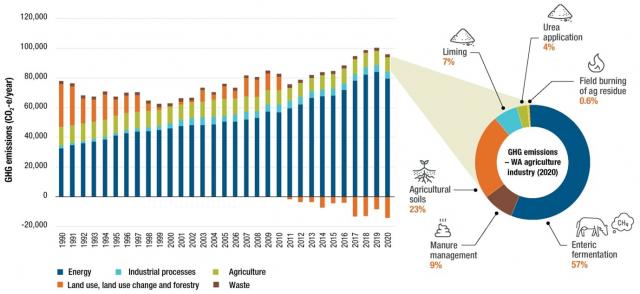In the future, climate change will drive increased average and maximum temperatures, time spent in drought and lead to more extreme weather events. In the south-west, the prolonged period of drying will continue, affecting primary industries, water security and natural ecosystems. These changes will potentially have broad impacts across our communities, industries and ecosystems. Warming trends and extreme events will affect our natural assets, such as Ningaloo Reef, and our global biodiversity hotspot in the south-west, which will have implications for how these regions are managed.
The Western Australian State Government has set a goal of becoming carbon neutral by 2050 and WA is taking action in reducing Greenhouse gas (GHG) emissions, both at an industry and government level. Reducing our emissions and contributing to the critical goals of the Paris Agreement will safeguard Western Australia’s environment, community, and long-term prosperity.
Shaping Western Australia’s low-carbon future set out the high-level process and objectives for delivering emissions reductions.
Sectoral emissions reduction strategy for Western Australia
Over 2022 and 2023 the State Government developed sectoral emissions reduction strategies to transition our economy to net zero emissions. The strategies were undertaken in consultation with business and industry, as well as research, environment and community organisations.
Sectoral emissions reductions strategy for Western Australia
The purpose of the Sectoral Emissions Reduction Strategy (SERS) is to provide robust, credible and cost-effective emissions reduction pathways across sectors for the whole of WA to guide emissions reductions across key economic sectors. The report, Sectoral emissions reduction strategy for Western Australia - Pathways and priority actions for the state’s transition to net zero emissions, was released in December 2023. Further SERS details can be found on the WA.gov.au site
Agricultural emissions and SERS
DPIRD led the development of the agricultural component of the Sectoral Emissions Reduction Strategies.
Reports that informed the agricultural component of SERS, include:
2020 Emissions Baseline Report for the Agriculture Sector in Western Australia
In order to track changes in emissions, a baseline is required to serve as a reference point. It also plays an important part in designing mitigation pathways. The 2020 Emissions Baseline Report for the Agriculture Sector in Western Australia provides that baseline for the agriculture sector and estimates of each industry within the sector. The full report was released in June 2022.
Greenhouse Gas Emissions Reduction Options for Western Australian Agriculture
With input from producers, business, industry, banking, DPIRD researchers, research institutions and other key stakeholders a consultation document was produced to inform the agricultural component of the Sectoral Emission Reduction Strategies.
DPIRD invited feedback on the relevance, value and adoptability of actions for different agricultural industries to achieve the goal of net zero emissions in the WA agricultural sector by 2050 through the Agricultural emissions reduction survey, which was released in March 2023 and accompanied the consultation document.
Feedback from the survey and outputs from prediction modelling informed the development of the agricultural component of SERS.
DPIRD is producing a technical report, to be released in 2024, which will provide comprehensive background information for industry to understand the greenhouse gas profile of agriculture.
Calculating emissions in the agricultural sector
Emissions can be calculated several ways. The state and national inventories are based on a set of rules outlined by the Intergovernmental Panel on Climate Change (IPCC) and it is how we report Australia’s emissions to the world on a country basis.
The report is broken into two parts:
1. Emissions from the national greenhouse gas inventory (NGHGI) method
2. Industry level analyses (life cycle analyses and farm carbon accounts)
to generate a baseline of GHG emissions for the WA agriculture sector and for each industry represented within the sector. Detailed analysis and scenario modelling to develop practical and effective abatement options, including shared transition pathways was undertaken in writing the report.
The NGHGI method estimates state and national GHG emissions using a set of rules outlined by the IPCC. These NGHGI emissions are used to report our emissions to the world and compare global emissions on a country-by-country basis. NGHGI reports gather emissions data from five sectors across the economy:
- Energy
- Industrial Processes
- Agriculture
- Land Use, Land Use Change; Forestry (LULUCF)
- Waste
Collectively, the emissions from these sectors make up Australia’s state and national emissions reported through the NGHGI.
Life cycle analysis (LCA) and carbon accounts are used to gather more detailed information about the sources and intensity of emissions along agricultural supply chains. These methods are used to drill down to a farm, enterprise or product level to generate emissions profiles for agricultural businesses and their inputs and products. This more detailed emissions information can be used to guide production efficiencies and carbon mitigation strategies along supply chains.
Establishing a baseline of agricultural emissions is needed to monitor changes in industry emissions over time. The emissions baseline will also play an important role in designing mitigation pathways.

Contact:
Gus Manatsa (PhD)
Emissions Lead
Climate Resilience Program
Email: gus.manatsa@dpird.wa.gov.au
Mobile: +61 473 615 409
